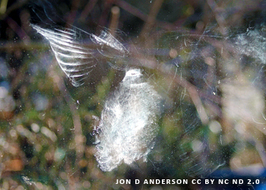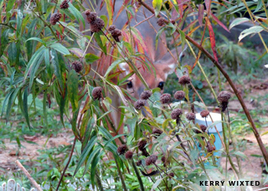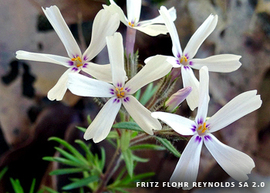|
|
Vol. 22, No. 3 | Spring 2018
|
|
|
Spring has finally sprung! After a seemingly endless winter, I am excited to welcome warmer temperatures, spring flowers and wildlife into my backyard. This issue includes information on spring visitors like flower flies—a pollinator and a predator—as well as a beautiful native groundcover, moss phlox.
In addition, spring is a time for migration, which can be hazardous for many birds. Check out our article on bird-safe windows for tips on how to make your home more bird-friendly as well as some recommendations by guest author, Clare Walker, on plants that help pollinators but often deter deer.
If there is a particular topic that you would like to include, please don’t hesitate to reach out.
Happy Habitats!
Kerry Wixted
|
|
 Bird Safe Windows
BAM! Have you ever had a bird hit one of your windows? Nearly a billion birds collide with windows each year, half of which happen with home windows.
Unfortunately, the majority of birds die as a result of their injuries; even those that may be able to fly away often sustain life-threatening injuries.
The good news is that window collisions are easy to reduce at many houses.
|
 Deer Resistant Plants for Pollinators
In sections of Maryland, high concentrations of white-tailed deer have created a demand for "deer proof" plants. In reality, though, there is no such thing. Deer may nibble on anything - especially when hungry - but they do dislike aromatics, prickly leaves and thorns.
A better alternative to planting invasive species is to look for Maryland native plants that are deer resistant.
|
|
|
 Flower Flies
It’s a bee! No, it’s a fly! Have you ever seen a fly masquerading as a bee in the garden? If so, then you may have encountered a flower or syrphid fly.
More than 130 species of flower flies are found in Maryland, and these animals serve both as important pollinators as well as predators in the garden.
|
|
 Moss Phlox
Are you in need of a good, native groundcover? Moss phlox (Phlox subulata) is a creeping groundcover in the Phlox family (Polemoniaceae).
This herbaceous perennial grows up to 9 inches tall and forms mats across the ground. It prefers full sun, but it can grow in sandy, rocky or loamy soil.
|
|
|
|
For more springtime tips and tricks, check out the HabiChat archives.
|
|
|
Wild Acres is a voluntary program that encourages residents to create backyard wildlife habitat. In addition to this seasonal newsletter, it offers fact sheets on how landowners can enhance their habitat for wildlife.
|
|
|
|
|
|